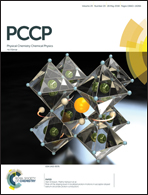Effect of π-bridge units on properties of A–π–D–π–A-type nonfullerene acceptors for organic solar cells†
Abstract
Acceptor–π–donor–π–acceptor (A–π–D–π–A)-types of small molecules are very promising nonfullerene acceptors to overcome the drawbacks of fullerene derivatives such as the weak absorption ability and electronic adjustability. However, only few attempts have been made to develop π-bridge units to construct highly efficient acceptors in OSCs. Herein, taking the reported acceptor P1 as a reference, five small-structured acceptors (P2, P3, P4, P5, and P6) have been designed via the replacement of the π-bridge unit. A combination of quantum chemistry and Marcus theory approaches is employed to investigate the effect of different π-bridge units on the optical, electronic, and charge transport properties of P1–P6. The calculation results show that the designed molecules P2 and P5 can become potential acceptor replacements of P1 due to their red-shifted absorption bands, appropriate energy levels, low exciton binding energy, and high electron affinity and electron mobility. Additionally, compared with P3HT/P1, P3HT/P2 and P3HT/P5 exhibit stronger and wider absorption peaks, larger electron transfer distances (DCT), greater transferred charge amounts (Δq), and smaller overlaps (Λ), which shows that P2 and P5 have more significant electron transfer characteristics and favorable exciton dissociation capabilities for enhancing the short-circuit current density (JSC) and thus, they are potential acceptors in OSCs.



 Please wait while we load your content...
Please wait while we load your content...